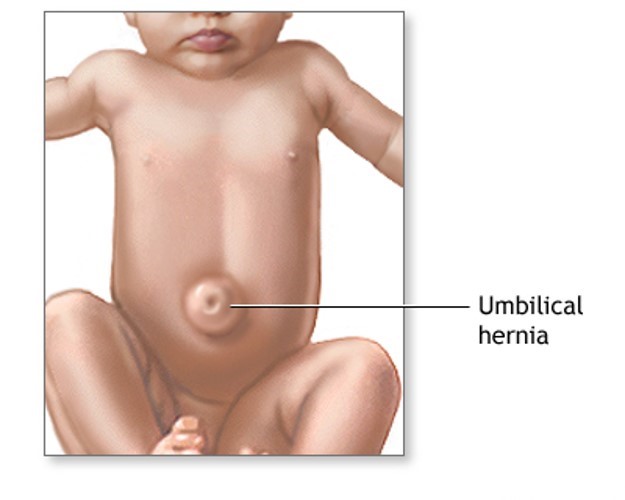Umbilical hernia
An umbilical hernia is an outward bulging (protrusion) of the lining of the abdomen or part of the abdominal organ(s) through the area around the belly button.
Causes
An umbilical hernia in an infant occurs when the muscle through which the umbilical cord passes does not close completely after birth.
Umbilical hernias are common in infants. They occur slightly more often in African Americans. Most umbilical hernias are not related to disease. Some umbilical hernias are linked with rare conditions such as Down syndrome.
Symptoms
A hernia can vary in width from less than 1 centimeter (cm) to more than 5 cm.
There is a soft swelling over the belly button that often bulges when the baby sits up, cries, or strains. The bulge may be flat when the infant lies on the back and is quiet. Umbilical hernias are usually painless.
Exams and Tests
A hernia is usually found by the health care provider during a physical exam.
Treatment
Most hernias in children heal on their own. Surgery to repair the hernia is needed only in the following cases:
· The hernia does not heal after the child is 3 or 4 years old.
· The intestine or other tissue bulges out and loses its blood supply (becomes strangulated). This is an emergency that needs surgery right away.
Outlook (Prognosis)
Most umbilical hernias get better without treatment by the time the child is 3 to 4 years old. If surgery is needed, it is usually successful.
Possible Complications
Strangulation of intestine tissue is rare, but serious, and needs surgery right away.
When to Contact a Medical Professional
Call your health care provider or go to the emergency room if the infant is very fussy or seems to have bad abdominal pain or if the hernia becomes tender, swollen, or discolored.
Prevention
There is no known way to prevent an umbilical hernia. Taping or strapping an umbilical hernia will not make it go away.



 Общие симптомы
Общие симптомы  Голова, зрение, слух, речь
Голова, зрение, слух, речь  Шея и горло
Шея и горло  Грудь, сердце и дыхание
Грудь, сердце и дыхание  Живот, желудок, кишечник
Живот, желудок, кишечник  Конечности, суставы, спина, поясница
Конечности, суставы, спина, поясница  Таз, мочеполовые органы
Таз, мочеполовые органы  Наружные поверхности, кожа, волосы
Наружные поверхности, кожа, волосы